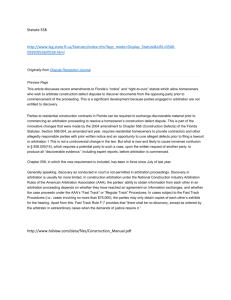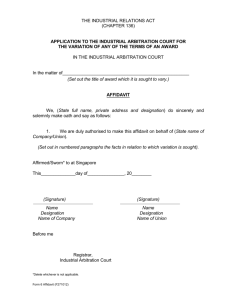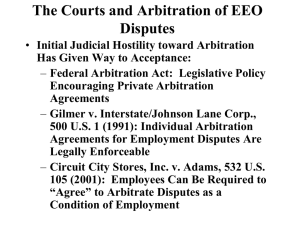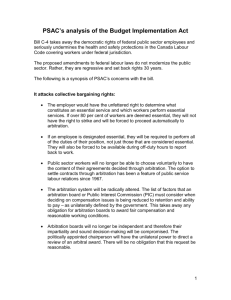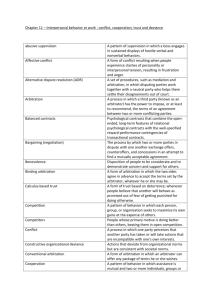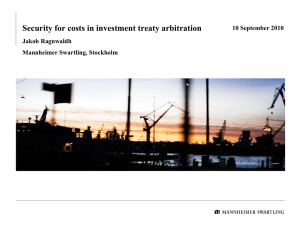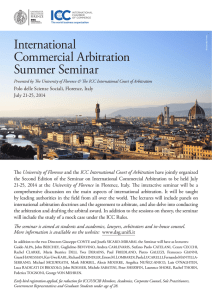International Tax Arbitration - University of Wisconsin Law School
advertisement
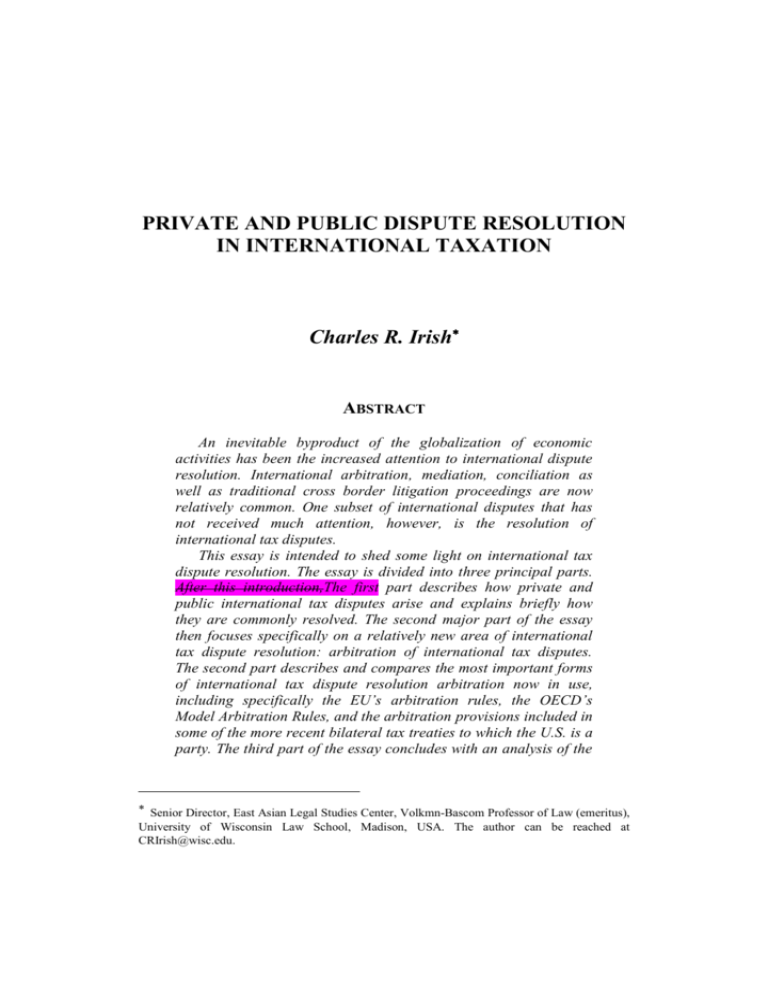
PRIVATE AND PUBLIC DISPUTE RESOLUTION IN INTERNATIONAL TAXATION Charles R. Irish ABSTRACT An inevitable byproduct of the globalization of economic activities has been the increased attention to international dispute resolution. International arbitration, mediation, conciliation as well as traditional cross border litigation proceedings are now relatively common. One subset of international disputes that has not received much attention, however, is the resolution of international tax disputes. This essay is intended to shed some light on international tax dispute resolution. The essay is divided into three principal parts. After this introduction,The first part describes how private and public international tax disputes arise and explains briefly how they are commonly resolved. The second major part of the essay then focuses specifically on a relatively new area of international tax dispute resolution: arbitration of international tax disputes. The second part describes and compares the most important forms of international tax dispute resolution arbitration now in use, including specifically the EU’s arbitration rules, the OECD’s Model Arbitration Rules, and the arbitration provisions included in some of the more recent bilateral tax treaties to which the U.S. is a party. The third part of the essay concludes with an analysis of the Senior Director, East Asian Legal Studies Center, Volkmn-Bascom Professor of Law (emeritus), University of Wisconsin Law School, Madison, USA. The author can be reached at CRIrish@wisc.edu. existing arbitration rules and suggestions for how they can be improved. KEYWORDS: Ⅰ. PRIVATE AND PUBLIC INTERNATIONAL TAX DISPUTES: GENERALLY A. The Nature of the Disputes International tax disputes arise in two general contexts. The first is probably the most common dispute and involves a taxpayer or taxpayers on one side and the government or governments on the other side. In these disputes, the government typically claims taxes are owed and the taxpayer resists the imposition of taxes. The second type of dispute involves two or more government arguing over the allocation of tax revenues derived from trade and investment transactions between their territories. In the second type of dispute, private taxpayers may have little or no direct role, although they may play important roles in attempting to influence the positions of governments in the intergovernmental negotiations. In both types of disputes, the amounts involved usually are very substantial and reach hundreds of millions or even billions of U.S. dollars.1 B. Disputes Between Taxpayers and the Government International tax disputes between taxpayers and the government can be divided into two categories: disputes in which the taxpayers claim there is international double taxation and disputes which could result in double non-taxation. Under the basic jurisdictional rules of international taxation, most countries with an income tax impose that tax on the global income of resident individuals and business enterprises under the residence principle, but they also tax foreign individuals and non-resident business enterprises on income that arises within their territory under the source principle. As a consequence, the fundamental structure of international taxation anticipates the risk of double taxation as the countries involved in international business often impose their taxes on the global income of their residents and the domestic source income of foreigners. Because double taxation of international income flows would kill off a great amount of international business and investment, it is not surprising that many of the international tax rules are aimed at reducing the risk of double taxation. 1 For the tax years 1989 to 2005, GlaxoSmithKline PLC, the British pharmaceuticals giant, agreed to pay the U.S. IRS US$3.4 billion to settle a transfer pricing controversy. See Michael J. Mcintyre, Comments on the OECD Proposal for Secret and Mandatory Arbitration of International Tax Dsiputes, 7(9) FLA. TAX REV. 622 (2006), at footnote 10, quoting Robert Guy Matthews and Jeanne Whalen: “Glaxo to Settle Tax Dispute With IRS Over U.S. Unit for $ 3.4 Billion”, Wall Street Journal, Sept. 12, 2006 at A3. Of all the international tax disputes, the most commonly encountered problems involve transfer pricing controversies. This is especially so with the globally integrated economy where so many transfers of goods, services and intangible property are between parents and subsidiaries or between other affiliated enterprises. “Transfer pricing” refers to the price charged on transfers of goods, services and intangible property between related entities. Thus, for example, if Am Corp is a U.S. based holding company with subsidiary operations in the U.S., Taiwan, and several other jurisdictions, the prices charged on transfers of anything of value among the subsidiaries and between Am Corp and its subsidiaries would be transfer prices. The essence of transfer prices is that they are set not by the market place, but are within the discretion of the multinational enterprises. It is generally accepted that transfer pricing controversies are one of the most common and most serious issues facing multinational enterprises and at any given time a majority of the largest multinational enterprises are involved in very substantial transfer pricing disputes somewhere in the world.2 Despite the enormous efforts at establishing uniformity in transfer pricing rules,3 the issues inevitably are so complex and dependent on so many subjective variables that transfer pricing disputes remain the most serious tax controversies facing multinational enterprises. 4 Example 1 illustrates how Am Corp could become involved in an international tax dispute related to transfer pricing. Example 1 In 2008, Am Corp licensed patents and copyrights to Taiwan Sub, Am Corp’s wholly owned subsidiary in Taiwan. Under the licensing agreement, Taiwan Sub agreed to pay royalties of US$10 million per year. In the year 2009, according to the licensing agreement, Taiwan Sub paid Am Corp US$10 million. In 2010, on reviewing Taiwan Sub’s income tax accounts for 2009, Taiwan’s National Tax Administration determined that the royalties paid by Taiwan Sub to Am Corp were excessive and that the proper amount of royalties in 2009 should have been only US$4 million. As a result, in computing Taiwan Sub’s Taiwan income tax liabilities, Taiwan’s National 2 See OECD, TRANSFER PRICING GUIDELINES FOR MULTINATIONAL ENTERPRISES AND TAX ADMINISTRATIONS (2010).[pincite] 3 The OECD and the UN both have developed extensive guidelines for the computation of transfer prices in international business. See, e.g., id. Most major economies, including Taiwan and the U.S., have their own transfer pricing rules that mirror or are similar to the OECD or UN Guidelines. 4 Yitzhak Hadari, Compulsory Arbitration in International Transfer Pricing and Other Double Taxation Disputes, available at http://papers.ssrn.com/sol3/papers.cfm?abstract_id=1483621 (last visited Oct. 20, 2011). [Please kindly provide the cited material.] Tax Administration disallowed US$6 million of Taiwan Sub’s tax deduction for the royalties paid to Am Corp. For the year 2009, Am Corp properly reported royalty income of US$10 million that is first subject to Taiwan’s withholding tax on outbound royalty payments and then again in the U.S.. Even though Am Corp is taxed in both Taiwan and the U.S., double taxation is avoided because Am Corp can claim the Taiwan withholding tax paid as a credit against its U.S. tax liability. However, because Taiwan Sub is now taxed in Taiwan on the US$6 million that was disallowed as deduction by the Taiwan’s National Tax Administration and Am Corp is taxed on royalty income of US$10 million, not US$4 million, the US$6 million is threatened with double income taxation because it is now being taxed in Taiwan in the hands of Taiwan Sub and it also is taxed in Taiwan and the U.S. in the hands of Am Corp. Because of the prevalence of intra-firm transfers of goods, services and intangible property in international transactions and the very considerable difficulties associated with computing accurate transfer prices, transfer pricing disputes arising under national income tax laws are the most frequent type of international tax dispute. Less common, but still troublesome disputes arise from inconsistent characterizations of international remittances. Example 2 illustrates a situation that creates a threat of double taxation when the source country characterizes a remittance as interest income and the recipient country treats the remittance as services income. Example 2 In 2009, U.S. Bank (“USB”) entered into an agreement to provide loan guarantees, lines of credits and other services for its British Banking Sub (“BBS”), its wholly owned subsidiary in London. In 2010, BBS paid USB US$12 million for the various services under the agreement. The UK Department of Inland Revenue determined that the US$12 million payments were in the nature of interest, which has its source in the UK and hence is taxable to USB in the UK. The U.S. International Revenue Service, however, determined that the payments constituted services income and had their source where the services were performed – in the U.S., not the UK. In this case, USB would be taxed on the US$12 million payment in the UK and also taxable in the U.S.. Unlike the situation in Example 1, however, the U.S. would not allow USB to offset the UK tax through the U.S. foreign tax credit because the credit is only allowed for foreign source income, as determined under U.S. tax rules. Because the U.S. has concluded that the payments were US source services income, no foreign tax credit would be available to eliminate the threat of double taxation. Other less common instances creating threats of double taxation are: Conflicting determinations of the residency of taxpayers, such as where the U.S. asserts that a taxpayer is a resident of the U.S. while Canada claims that the taxpayer is a Canadian resident. Inconsistent determinations on the legal status of a taxpayer as a conduit or pass-through entity (i.e., a partnership) or a separate entity (i.e., a traditional corporation). Different views on the status of a tax as an income tax that qualifies for the foreign tax credit (e.g., Brazil imposes a withholding tax on interest paid to U.S. lenders, but the U.S. determines that the tax is not properly characterized as an income tax and thus does not qualify for the U.S. foreign tax credit). The other category of international tax disputes involving private parties is where the controversy could result in double non-taxation. These cases are less common than double taxation controversies, but the growing importance of sovereign wealth funds and large pension funds as foreign investors makes these cases increasingly relevant. Example 3 illustrates one such case. Example 3 TIAA-CREF is one of the largest financial services companies in the US with assets of about US$400 billion. The income of TIAA-CREF is tax exempt in the U.S. because it is qualified as a tax exempt pension fund. Taiwan, however, has much more limited tax exemptions for foreign institutions so TIAA-CREF’s investments in Taiwan are potentially subject to withholding taxes. TIAA-CREF may seek to persuade Taiwan’s National Tax Administration to extend tax exempt status to foreign pension funds and other exempt institutions where the home country of the pension funds grants a reciprocal exemption for tax exempt Taiwanese pension funds with investments in that country.5 5 The U.S. tax law is actually generous in unconditionally granting tax exempt status to sovereign wealth funds and other governmental entities irrespective of the tax treatment of U.S. sovereign wealth funds and governmental entities in the other countries. See Internal Revenue Code of 1986, §892. If this situation arose between countries with a bilateral income tax treaty, such as the U.S. and Denmark, TIAA-CREF would look to the Mutual Agreement Procedure (“MAP”) in the tax treaty to make use of the Competent Authority Procedure. Under Article 26 of the U.S./Danish Tax Treaty, TIAA-CREF would try to persuade the U.S. Competent Authority (a bureaucrat within the U.S. Treasury) to persuade the Danish Competent Authority that it is a qualified pension fund that fits within the definition in the U.S./Danish income tax treaty. If the U.S. Competent Authority agrees to help TIAA-CREF and the Danish Competent Authority then agrees with the U.S. Competent Authority that TIAA-CREF is included within the definition of a qualified pension fund in the bilateral tax treaty, TIAA-CREF’s passive investment income from Denmark would be taxed in neither Denmark nor the U.S.. C. Disputes Between Governments International tax disputes between governments center on the allocation of tax revenues between the various territories. Most of the disputes take the form of bilateral negotiations that result in the conclusion of bilateral tax treaties, while others are more subtle and may even be so subtle that one side does not understand that there is a controversy. Example 4 illustrates intergovernmental tax negotiations and Example 5 describes a subtle controversy. Example 4 The U.S. Government is sporadically involved in income tax treaty negotiations with Sub-Saharan African countries. 6 One of the issues in the tax treaty negotiations is the rate of the source based withholding tax on royalties for patents, copyrights and trademarks used in one country and paid to enterprises resident in the other country. In other words, the negotiations will decide the maximum rate of tax that the U.S. Government can impose on royalties paid by U.S. enterprises to African enterprises and, because the negotiations impose reciprocal obligations, the U.S. rate also will determine the maximum rate that the African governments can impose on royalties paid by African enterprises to U.S. enterprises. Technological flows between the U.S. and Sub-Saharan Africa 6 Allison D. Christians, Tax Treaties for Investment and Aid to Sub-Saharan Africa, 71(2) BROOK. L.REV. 639, 641 (2005). are not reciprocal, but instead it is much more common for U.S. enterprises to license technology to Africa than for African enterprises to license technology to the U.S.. As a consequence, royalties between the U.S. and Africa will flow largely one-way from Africa to the U.S. so that if the source based withholding tax is set at zero percent the African governments will obtain virtually no revenues from U.S./Africa technology flows and the U.S. will be able to impose the full rate of its corporate tax (35% of net income) on the technology flows. On the other hand, if the source based withholding tax is set at 20%, the African governments will receive 20% of the gross income from the technology flows and the U.S. will have only the residue revenues after allowing a credit for the African withholding taxes.7 Example 5 In the 1990s, the U.S. adopted aggressive transfer pricing rules with heavy penalties for non-compliance. Even though the U.S., Korean and many other governments have adopted detailed rules to determine transfer prices, the reality is that there is an exceptionally high level of uncertainty in many transfer prices. The combination of aggressive transfer pricing rules, severe penalties for non-compliance, and a high level of uncertainty about what was acceptable caused multinational enterprises with operations in the U.S. to adjust their transfer prices so that they minimized the risks of confrontation with the U.S. tax authorities. The result was that the multinational enterprises tended to overstate their U.S. income, because of the greater risk of audit and severe penalties, and understate their income in other jurisdictions where the risks of audit were lower and the penalties less harsh.8 Ⅱ. RESOLUTION OF INTERNATIONAL TAX DISPUTES: AN OVERVIEW A. Resolution of Disputes Between Taxpayers and the Government 7 For a more detailed discussion of this problem, see Charles R. Irish, International Double Taxation Agreements and Income Texation at Source, 23(2) INT’L & COMP. L.Q. 292 (1974).[material][pincite] 8 For a more detailed discussion of this problem, see Charles R. Irish, The Other Harmful Tax Competition, 24 TAX NOTES INT’L 901 (2001).[material][pincite] International tax disputes between taxpayers and the governments are resolved either prospectively through advanced government rulings on the tax consequences of a proposed transaction, most notably advanced pricing agreements (“APAs”), or after the fact through negotiations with national tax authorities, under the mutual agreement procedures in bilateral tax treaties, and in a few instances through voluntary or binding arbitration also under the mutual agreement procedures in bilateral tax treaties. Taiwan, the U.S., Korea, Japan, China and many other countries have procedures for the issuance of advanced pricing agreements (“APAs”) in transfer pricing controversies.9 In some cases, taxpayers are able to obtain APAs in transfer pricing cases involving both customs duties and income taxes. 10 It also is very common for bilateral or multilateral APAs to be concluded so a taxpayer is able to secure commitments on the tax consequences of future transactions from all interested tax administrations.11 For example, in June, 2009, the State Administration of Taxation of China (“SAT”) and the Danish Tax Authorities (“DTA”) completed negotiations for two bilateral advance pricing agreements involving a leading Danish technology company and two of its Chinese subsidiaries. The APAs, which covered almost all types of related party transactions, are the first of their kind between China and a European country. 12 In 2011, China and Denmark concluded a third bilateral advanced pricing agreement, although Denmark remains the only European country to have APAs with China.13 International tax disputes not settled in advance through APAs or other advance rulings typically begin with negotiations with national tax authorities. In Example 1 above, Am Corp would complain to the Taiwan National Tax Administration that, because US$6 million was disallowed as a deduction for Taiwan Sub, it should only be taxed in Taiwan on US$4 million. Am Corp would make the same argument to the US Internal Revenue Service. If the Taiwan National Tax Administration and the US 9 Deloitte, Strategy Matrix for Global Transfer Pricing: Planning for Methods, Documentation, Penalties and Other Issues 2008, available at http://www.iasplus.com/dttpubs/0807transferpricing.pdf (last visited Oct. 20, 2011). 10 See http://www.pwccn.com/home/eng/tp_apa_cn_kr_jan2008.html (last visited Oct. 20, 2011). [the link doesn’t exist] 11 See OECD, Guidelines for Conducting Advanced Pricing Arrangements Under the Mutual Agreement Procedure (“MAP APAs”), available at http://www.oecd.org/dataoecd/10/10/38008392.pdf (last visited Oct. 20, 2011). 12 Price Waterhouse Coopers [hereinafter PWC], Pricing Knowledge Network, PKN Stop Press China — China Concludes the Negotiations of the First European Bilateral Advance Pricing Arrangement with Denmark, available at http://www.publications.pwc.com/DisplayFile.aspx?Attachmentid=2292&Mailinstanceid=12074 (last visited Oct. 20, 2011). 13 PWC, PKN — Third Bilateral APA Concluded Between Denmark and China, available at http://www.pwccn.com/webmedia/doc/634438150496233653_cn_dm_tp_apa_jun2011.pdf (last visited Oct. 20, 2011). Internal Revenue Service do not agree to reduce Am Corp’s Taiwan source income by the amount of Taiwan Sub’s disallowed deduction, Am Corp would have to undertake negotiations with the Taiwan National Tax Administration and the U.S. Internal Revenue Service. Given the absence of formal diplomatic relations between Taiwan and the U.S. and the lack of a bilateral income tax treaty, there is no formal mechanism for working with both governments simultaneously, so Am Corp will have to undertake cumbersome negotiations with both governments and provide its own coordination between the two governments. If Example 1 involved two countries with a bilateral income tax treaty, such as the treaty between the U.S. and Korea,14 Am Corp could make use of the Mutual Agreement Procedure in Article 27 of that treaty. 15 Under Article 27, the Korean and U.S. tax agencies are obliged to work together to resolve inconsistent applications of the tax laws that result in double taxation that is inconsistent with the Korea/U.S. tax treaty. Article 27 does not, however, impose a binding obligation on either the Korean National Tax Service of the U.S. Internal Revenue Service to reach an agreement eliminating the risk of double taxation. The mutual agreement procedures in more recently concluded bilateral tax treaties often contain mechanisms for compulsory arbitration. The European Union arbitration convention of 1995 has adopted arbitration as a solution for double taxation that arises due to transfer pricing disputes.16 An arbitration provision with a broader scope now is included in Article 25 of the 2008 OECD Model Income Tax Convention. Under Article 25(5), if the competent authorities fail to resolve a controversy submitted to them within two years, any unresolved issues must be submitted to arbitration if the taxpayers request it.17 Recent amendments to bilateral tax treaties also contain arbitration provisions for resolving tax disputes. Many of these various arbitration regimes are discussed in greater detail in the next part of this paper. B. Resolution of Disputes Between Governments In some cases, governments conclude specific revenue sharing agreements. The Isle of Man and the UK Finance Ministry, for example, have an agreement that divides the revenues from value added taxes 14 United States- Republic of Korea Income Tax Convention, available at http://www.irs.gov/pub/irs-trty/korea.pdf (last visited Oct. 20, 2011). 15 Id. 16 Hadari, supra note 4, at 4. 17 OECD, Model Tax Convention on Income and on Capital (July 18, 2008), at 17, available at http://www.oecd.org/dataoecd/14/32/41147804.pdf between the UK and the island.18 Bilateral income tax treaties are, however, the most common way of allocating revenues between governments. There are hundreds of tax treaties in effect around the world. The U.S., for example, has about 58 income tax treaties that affect tax relations with most major economies in the world (except Taiwan).19 Korea also has an extensive tax treaty network with over 60 bilateral income tax treaties currently in force, including a relatively old treaty (1979) with the U.S. that has been the object of renegotiation for several years.20 Income tax treaties provide detailed rules on the taxation of income that arises between the two contracting parties. Most of the tax treaties are modeled after the OECD model income tax treaties21 and they are structured to avoid double taxation, principally by limiting the power of the source country to imposes taxes on income that arises within with their territory and then requiring the residence to either grant a credit for the source based taxes or to exempt the income subject to the source based withholding taxes. When governments have unilaterally adopted aggressive tactics to gain greater shares of tax revenues, such as with the U.S. aggressive transfer pricing rules illustrated in Example 5, other governments sometimes have responded with their own aggressive rules and practices so as to rebalance allocation of revenues. Faced with the loss of revenues because of the U.S. transfer pricing rules described in Example 5, for example, the Canadian Government introduced its own tougher transfer pricing rules to limit the instances when companies tilted their transfer prices towards the U.S..22 Ⅲ. INTERNATIONAL TAX ARBITRATION RULES A. An Introduction to the Mutual Agreement Procedure As mentioned above, the principal purpose of bilateral income tax treaties is to allocate revenues from international business between two countries. Included in the provisions of typical income tax treaties is an article establishing a “Mutual Agreement Procedure” (“MAP”). The purpose of MAP is to offer taxpayers a diplomatic remedy when they feel that their tax consequences are not consistent with the terms of the tax Andrew Bounds, Isle of Man Faces €50 million Pound Tax Clawback, FINANCIAL TIMES (U.S. 21, 2009, at 4.[Please kindly provide the cited material.] 19 Department of the Treasury, U.S. Tax Treaties, Publication 901 (Rev. April 2011), Cat. No. 46849F, at 55-56, available at http://www.irs.gov/pub/irs-pdf/p901.pdf (last visited Oct. 20, 2011). 20 Linex Systems, http://www.linexlegal.com/content.php?content_id=76581 (last visited Oct. 20, 2011). 21 OECD, OECD Model Tax Convention on Income and on Capital: An Overview of Available Products, http://www.oecd.org/document/37/0,3343,en_2649_33747_1913957_1_1_1_1,00.html (last visited Oct. 20, 201111). 22 Irish, supra note 8, at .[pincite] 18 EDITION), Oct. treaty. Under the U.S. tax treaty with Korea, for example, if a U.S. Corporation (“USC”) thinks that its operations in Korea are being taxed too heavily, it may ask the U.S. Competent Authority to contact the Korean Competent Authority to deal with its complaint. If the U.S. Competent Authority determines that the claim of USC has merit, it will contact the Korean Competent Authority and seek an adjustment to USC’s tax accounts in Korea. If the Korean Competent Authority agrees with the U.S. Competent Authority, an adjustment to USC’s Korean tax burden will follow. The key elements of the traditional MAP are as follows: The competent authority receiving the initial complaint is under no obligation to accept the complaint. In the U.S., some courts have refused to compel the U.S. Competent Authority to accept a complaint apparently on the ground that the decision to accept a complaint is within the complete discretion of the U.S. Competent Authority.23 In other countries, however, the courts have referred taxpayers to the mutual agreement procedure in lieu of domestic litigation.24 Contacts under the MAP are purely between the governments. The taxpayer raising the complaint is not a party to the negotiations and has no right to appear or make submissions to the competent authorities. The government to government negotiations are confidential, even to the taxpayer raising the complaint. Written documents exchanged between the competent authorities also are not available to the taxpayer involved. There generally are no specific time limits within which the competent authorities have to act. There is no obligation on the part of either competent authority to reach an agreement that avoids double taxation.25 Except for the taxpayer making the complaint, the outcome of the competent authority negotiations is confidential. The results are not publicly reported. B. The EU Arbitration Convention 23 Hadari, supra note 16, at 6. Id. at 7, referring to a decision of the Israeli District Court. 25 A good illustration of competent authorities not reaching an agreement is a tax case involving the noted musician Pierre Boulez. The issue in the case was whether certain payments received by Pierre Boulez under a contract with CBS constituted royalties or compensation for personal services. Had the payments been characterized as royalties, they would have been exempt from U.S. tax. Had they been compensation for personal services, they would have been subject to U.S. tax. Under the MAP of the U.S.-German tax treaty, the German competent authority concluded that payments were royalties, while the American competent authority decided the payments were compensation. The end result was that Boulexz was taxed twice on the income. 24 The EU Arbitration Convention (“Arbitration Convention”), which first became effective in 1995, establishes a procedure to resolve disputes where double taxation occurs between related enterprises of different EU Member States as a result of a transfer pricing adjustment in one Member State. Article 7 of the Arbitration Convention provides that if the competent authorities of two members states fail to reach agreement on a transfer pricing dispute within two years after the complaint is first submitted to one of the competent authorities, they must establish an advisory commission that will deliver an opinion on eliminating the double taxation.26 The advisory commissions are composed of two representatives from the competent authorities of each party and an even number of experts and independent persons picked from a list of experts.27 The enterprises complaining about the transfer pricing adjustment have the right to make submissions and to appear during the arbitration process.28 The advisory commission then is obligated to give an opinion on the elimination of double taxation within six months of getting the case and the competent authorities have an additional six months to decide the case. 29 If the competent authorities fail to decide the case within the additional six months, the opinion of the advisory commission prevails.30 The competent authorities may agree to publish the decision, but only if the affected enterprises agree to publication.31 The key elements of the EU Arbitration Convention are as follows: The convention only applies to transfer pricing controversies within EU member states. The competent authorities are only obligated to accept a complaint if they determine that the complaint is “well founded”32 and it is not clear whether a competent authority’s refusal to accept a complaint is subject to judicial review in the home country of the competent authority. Because each case is referred to and settled by international procedures, “irrespective of the remedies provided by the domestic laws of the Contracting States concerned,” the domestic and international procedures are not mutually exclusive and do not compete as the mutual agreement is only binding on the Contracting States, not on the national courts. The affected enterprises are therefore placed in a 26 The Convention for the Elimination of Double Taxation in Connection with the Adjustment of Profits of Associated Enterprises, art. 7, available at http://eurlex.europa.eu/LexUriServ/LexUriServ.do?uri=CELEX:41990A0436:en:HTML (last visited Oct. 20, 2011). 27 Id. art. 9(1). 28 Id. art. 10(2). 29 Id. art. 12(1). 30 Id. 31 Id. art. 12(2). 32 Id. art. 6(2). tactical position of having optional parallel proceedings. The enterprises can choose one or the other, or a combination of both. In the latter case, the enterprises can choose to call for the discontinuation of the international procedure if it is satisfied with the elimination of double taxation afforded by a decision of the national courts.33 During the initial stage when the negotiations are between the two competent authorities there is no indication that the enterprises have a right to be involved. Once the process moves into the arbitration phase, however, the enterprises have the right to make submissions and to appear before the advisory commission. The two year time limit that triggers the arbitration process can be extended by mutual agreement of the competent authorities and with the agreement of the associated enterprises concerned.34 The members of the advisory commission are obligated to treat the arbitration process as secret. Unless the competent authorities reach an agreement within six month after the decision of the advisory commission, the decision of the advisory commission is binding on all parties. Some have suggested that the complainant, who is not technically a party in the MAP arbitration process, may choose not to accept the arbitration decision and instead litigate the issue in domestic courts.35 Once a decision is rendered, the competent authorities may publish the decision but publication is permissible only if the affected enterprises agree. C. The OECD Model Income Tax Convention The OECD Fiscal Affairs Committee and its current successor the Center for Tax Policy and Administration have undertaken extensive studies of the role of tax treaties in avoiding double taxation and preventing fiscal evasion. Among the most prominent outcomes of these studies are various iterations of a model bilateral income tax convention. Most tax treaties in force today strongly resemble these model conventions as they have evolved over the years since the first model was published in 1958. The 2008 OECD Model Income Tax Convention is the latest version of the OECD models. Paragraphs 1 through 4 of Article 25 of that model contain the traditional MAP as discussed above. Article 25, Paragraph 5 added arbitration as a new element to the MAP in the 2008 Model. Under Article 25(5), if the competent authorities are unable to reach an agreement 33 Jean-Philippe Chetcuti, The EU Tax Arbitration Convention, at 6.6, http://www.interlawyer.com/lex-e-scripta/articles/eu-tax-arb-conv.htm#_Toc518052897 (last visited Oct. 20, 2011). 34 Id. at 7.4. 35 Hadari, supra note 4, at 7; Chetcuti, supra note 33. to resolve the complaint within two years after it is submitted to them, any unresolved issues are to be submitted to arbitration if the complainant so requests. 36 The complainant requesting the arbitration can make written submissions during the arbitration process and, with the assent of the arbitrators, present his case orally during the arbitration proceedings.37 The arbitration decision is binding on the competent authorities, although the complainant can refuse to accept the decision and litigate the issue on local courts.38 The arbitrators are treated as the authorized representatives of the competent authorities and are subject to the same strict confidentiality requirements as the competent authorities.39 The arbitration decision may be published, but only with the consent of both competent authorities and the complainant. Even then, only the basic elements of the decision should be published and the name of the complainant should not be disclosed.40 Among the key features of the arbitration provisions in the 2008 OECD Model Income Tax Convention are the following: As under the traditional MAP, the competent authorities are only obligated to accept a complaint if they determine that the complaint is “well founded”.41 It has been suggested that in some jurisdictions the decision of the competent authority to accept or reject a complaint may be subject to judicial review, with the standard of review similar to that applied to administrative decisions generally.42 MAP Arbitration is generally available for any tax disputes that involve the underlying tax treaty; it is not limited to the resolution of transfer pricing disputes as under the EU Arbitration Convention. The complainant requesting the arbitration can make written submissions during the arbitration process and, with the assent of the arbitrators, present his case orally during the arbitration proceedings.43 The arbitration process is an integral part of the MAP. As a result, arbitration only is available when the competent authorities have left unresolved issues. If the competent authorities have agreed on all of the issues, arbitration is not allowed even if taxpayer disagrees with the decision.44 The OECD Model arbitration agreement takes as the starting point the independent opinion approach to deciding a case. The OECD 36 Supra note 17, at 16. OECD, The 2008 Update to the OECD Model Tax Convention, at 99, available at http://www.oecd.org/dataoecd/20/34/41032078.pdf (last visited Oct. 20, 2011). 38 Supra note 17, at 16. 39 Supra note 37, at 105. 40 Id. at 108-09. 41 Supra note 17, art. 6(2). 42 Hadari, supra note 4, at 7. 43 Supra note 37. 44 Supra note 17, at 373. 37 recognizes, however, that use of other methods, such as the last best offer method, may be suitable in some circumstances.45 The arbitration decision is binding on the competent authorities, but apparently not on the taxpayer who can decline to accept the arbitration decision and pursue the dispute in domestic courts.46 The costs of the arbitration process are borne by the competent authorities, although any expenses incurred by the complainant in making written submissions or oral presentations should be borne by the complainant.47 Although an arbitration decisions under Article 25(5) is not intended to serve as formal precedent, the OECD has recognized that having the decision available to the public would make the process more transparent and it might influence the course of subsequent disputes and it could contribute to greater uniformity of tax law administration.48 As a consequence, arbitration decisions under Article 25(5) may be published, but only if the complainant agrees. In addition, if the decision is published, it should be done in such a fashion as to maintain the confidentiality of the complainant.49 D. Dispute Resolution Under U.S. Income Tax Treaties The U.S. Model Income Tax Treaty does not include the option of arbitration to resolve international tax disputes.50 Nonetheless, some of the major treaties to which the U.S. is a party have been amended to add arbitration provisions to the MAP. The amendments to the U.S. tax treaties with Germany, Canada and Belgium offer good illustrations of the U.S. arbitration rules governing international tax disputes. The German protocol, which became effective in December, 2007, provides that arbitration is not fully mandatory in that the competent authorities by mutual agreement may decide not to arbitrate a particular matter. The protocol also provides for full secrecy of the proceedings and does not require the arbitrators to prepare a report. Instead, the arbitrators simply pick between the settlement proposals made by the two parties in what is known as “last best offer” or “baseball arbitration”. As with the results of traditional MAP proceeding, the outcome of the arbitration is disclosed only to the concerned taxpayer and its representatives, again under a requirement of confidentiality. Only 45 Id. at 102. Id. art. 25(5). 47 Supra note 37, at 99-100. 48 Id. at 108. 49 Id. at 109. 50 See United States Model Income Tax Convention of November 15, 2006, art. 25(5), http://www.irs.gov/pub/irs-trty/model006.pdf (last visited Oct. 20, 2011). 46 enumerated issues, including transfer-pricing disputes, are subject to arbitration. The Canadian and Belgian arbitration provisions follow the German provisions in all material aspects. The key elements of the arbitration provisions under U.S. treaties with Germany, Canada and Belgium are as follows:51 In general, arbitration is mandatory if the competent authorities cannot reach agreement, but the competent still may mutually agree that a particular matter is not suitable for arbitration. Arbitration is only available for disputes involving specific provisions of the underlying tax treaty, including transfer pricing disputes, but the competent authorities may agree to arbitrate any controversy covered by the traditional MAP. When a complaint is accepted for arbitration, each competent authority is to appoint one arbitrator and the two arbitrators then are to appoint a third arbitrator who is to act as chair of the arbitration commission. The arbitration process requires that each competent authority prepare a proposed resolution of the controversy, with the arbitration commission then selecting one of the proposed resolutions. In other words, the arbitration decision is reached using the last best offer method. The arbitration decision is binding on the competent authorities. The complainants have the option whether to accept the arbitration decision of litigate the issue in domestic courts. The fees and expenses of the arbitration process costs of the arbitration process are to be borne equally by the competent authorities. 51 The details of the arbitrations provisions in the U.S. treaties with Germany, Canada and Belgium can be obtained form the following sources: Protocol Amending the U.S.-German Tax Treaty, http://www.irs.gov/pub/irs-trty/germanprot06.pdf; id.,Technical Explanation of the U.S./German Protocol [the last material cited is not as same as the present one.]; U.S./Germany Tax Treaty Modified to Include Mandatory Arbitration in Certain Circumstances, http://www.irs.gov/businesses/international/article/0,,id=181003,00.html; Protocol to U.S.-Canada Tax Treaty 2007, http://www.treasury.gov/resourcecenter/taxpolicy/treaties/Documents/CanadaProtocol07.pdf; Technical Explanation of the U.S.-Canada Protocol, http://www.treasury.gov/resource-center/taxpolicy/treaties/Documents/tecanada08.pdf; Convention between the Government of the United States of America and the Government of the Kingdom of Belgium for the Avoidance of Double Taxation and the Prevention of Fiscal Evasion With Respect to Taxes on Income, http://www.irs.gov/pub/irs-trty/belgiumtt06.pdf; 2006 Protocol to U.S.-Belgium Tax Treaty, http://www.irs.gov/pub/irs-trty/belgiumprot06.pdf; 2007 Technical Explanation of the U.S.Belgium Tax Treaty, http://www.irs.gov/pub/irs-trty/belgiumte07.pdf; U.S.-Belgium Tax Treaty Mutual Agreement Procedure Arbitration Processes Announcement on Arbitration 2009, http://www.irs.gov/businesses/small/international/article/0,,id=205324,00.html; U.S.-Belgium Tax Treaty Arbitration Guidelines 2009, http://www.irs.gov/businesses/international/article/0,,id=209577,00.html (all sites last visited on Oct. 20, 2011). The proceedings and the arbitration decision are to be regarded as confidential with no public disclosure. E. Questions and Concerns About Tax Treaty Arbitration The introduction of arbitration proceedings to resolve international tax disputes between taxpayers and governments is generally regarded as a step in the right direction. It certainly has been endorsed as an appropriate reform by the OECD and the International Chamber of Commerce. The use of last best offer or baseball arbitration rules to resolve controversies seems especially noteworthy because it encourages both sides to adopt more reasonable positions in controversies often fraught with great uncertainties. The last best offer approach seems especially attractive for transfer pricing cases because of the wide range of possibilities typically available as defensible transfer prices. There are, however, two major questions about the new tax arbitration rules: (i) Are the traditional MAPs so deficient as to require the introduction of a more formalized system of dispute resolution? and (ii) Are the new tax arbitration rules designed to serve the public interest? F. Is International Tax Arbitration Necessary? Because of the secrecy surrounding the MAP generally, little is known about its effectiveness. It appears that no study has been done on the efficacy of the MAP process as currently implemented and such a study would be difficult or impossible to conduct, given the confidentiality rules embedded in the MAP practices.52 The arbitration provisions were added to the OECD Model Tax Convention only after a great amount of study and lobbying involving two major private sector institutions – the International Fiscal Association (IFA) and the International Chamber of Commerce (ICC) and there is no evidence that existing MAP processes were serious deficient. The scant evidence that does exist suggests that there is not a significant void waiting to be filled by the arbitration rules. The OECD report explaining the proposed tax arbitration rules said that “in the rare cases where the competent authorities are unable to reach agreement, the unresolved issues will, at the request of the person who presented the case, be resolved through an arbitration process.” 53 When the EU Arbitration Convention was renewed in 2005, the EU reported that in the ten years 52 Allison Christians, Your Own Personal Tax Law: Dispute Resolution Under the OECD Model Tax Convention, 17() WILLAMETTE J. INT’L L. & DISPUTE RES. 172, 180 (2009).[material] 53 OECD, Proposals for Improving Mechanisms for the Resolution of Tax Treaty Disputes, at 6, 45, 91, http://www.oecd.org/dataoecd/5/20/36054823.pdf (last visited Oct. 20, 2011). since its inception the tax arbitration process had been used only twice with a third case pending.54 So, there is a serious question about whether the tax arbitration process is necessary. There also is the possibility that some modest measures, such as allowing greater participation by taxpayers from the beginning of the competent authority process, could remove any significant deficiencies in the MAP processes. G. Is International Tax Arbitration in the Public Interest? An even more serious question is whether the new tax arbitration rules are in the public interest. Those who have looked at this question with an objective mind have suggested that the tax arbitration rules are better designed to serve the international business community than serve the public interest.55 The number one criticism of the tax arbitration process is the secrecy surrounding it. Both the EU Arbitration Convention and the OECD Model Income Tax Convention allow for limited publication of the arbitration results, but even the barebones publication of the outcome can be blocked by the taxpayers who initiated the competent authority proceedings and it seems likely that taxpayers will often use this privilege to block publication. The result is that the international business community now can bypass the domestic administrative and judicial procedures normally available for resolving tax disputes and instead move into a secret forum outside the scrutiny of the taxpaying public. This possibility seems like a bad idea for at least three reasons: As the OECD itself has recognized, publication of the arbitration decisions improves the transparency of the taxing process and may influence the settlement or avoidance of future disputes. Allowing full secrecy of the process means that the process will not be transparent and the possibility of informal precedential value of the decisions will be lost. Secrecy in the arbitration process creates the opportunity for corruption or other improper influences by the taxpayers on the competent authorities. The lack of transparency risks development of a two tiered tax system where a limited group of taxpayers who communicate among themselves have a better understanding of the dangers and the loopholes in a particular tax system. In the 1970s, the confidentiality of private letter rulings in the US was discontinued precisely because of 54 55 OECD Report.[material] See, e.g., Christians, supra note 52, at172; Mcintyre, supra note 1,[pincite]. this reason – the confidentiality of the rulings enabled the U.S. Treasury to adopt tax policies favorable to a particular industry (principally the oil industry) well outside Congressional or public oversight. In defense of rigorous confidentiality is the fact that outcomes of most arbitration cases are secret. But most arbitration cases involve private parties dealing with issues of private controversies, which is very different from the resolution of public tax issues with major revenue (and possibly precedential) consequences.56 If the use of international tax arbitration is to continue, as appears likely given the strong support of the international business community, two adjustments need to be made. First, taxpayer participation in the competent authority process should be allowed from the beginning of the process. Second, the arbitration process and decisions should be made public. Some have argued against greater participation by private parties due to concerns that the private parties will overwhelm the competent authorities. That certainly is a risk, especially where multinational enterprises are working with tax administrations in smaller, less developed countries, but the risk is likely to be minimized if the process itself is subject to greater transparency. There also is the argument that confidentiality is necessary to maintain business secrets of the taxpayers, but in other areas, such as with private letter rulings in the U.S., the confidentiality of sensitive business information is maintained even though the tax issues involved in the ruling are discussed and resolved in a relatively thorough fashion. 56 Id. REFERENCES Books OECD (2010), TRANSFER PRICING GUIDELINES FOR MULTINATIONAL ENTERPRISES AND TAX ADMINISTRATIONS. Articles Mcintyre, Michael J. (2006), Comments on the OECD Proposal for Secret and Mandatory Arbitration of International Tax Dsiputes, 7(9) FLORIDA TAX REVIEW 622. Christians, Allison D. (2005), Tax Treaties for Investment and Aid to SubSaharan Africa, 71(2) BROOKLYN LAW REVIEW 639, 641. Irish, Charles R. (1974), International Double Taxation Agreements and Income Texation at Source, 23(2) INTERNATIONAL AND COMPARATIVE LAW QUARTERLY 292. Irish, Charles R. (2001), The Other Harmful Tax Competition, 24 TAX NOTES INTERNATIONL 901. Christians, Allison D. (2009), Your Own Personal Tax Law: Dispute Resolution Under the OECD Model Tax Convention, 17() THEWILLAMETTE JOURNAL OF INTERNATIONAL LAW AND DISPUTE RESOLUTION 172. Websites Hadari, Yitzhak, Compulsory Arbitration in International Transfer Pricing and Other Double Taxation Disputes, available at http://papers.ssrn.com/sol3/papers.cfm?abstract_id=1483621. Deloitte, Strategy Matrix for Global Transfer Pricing: Planning for Methods, Documentation, Penalties and Other Issues 2008, available at http://www.iasplus.com/dttpubs/0807transferpricing.pdf. http://www.pwccn.com/home/eng/tp_apa_cn_kr_jan2008.html.(Fn10) OECD, Guidelines for Conducting Advanced Pricing Arrangements Under the Mutual Agreement Procedure (“MAP APAs”), available at http://www.oecd.org/dataoecd/10/10/38008392.pdf. Price Waterhouse Coopers, Pricing Knowledge Network, PKN Stop Press China — China Concludes the Negotiations of the First European Bilateral Advance Pricing Arrangement with Denmark, available at http://www.publications.pwc.com/DisplayFile.aspx?Attachmentid=229 2&Mailinstanceid=12074. Price Waterhouse Coopers, PKN — Third Bilateral APA Concluded Between Denmark and China, available at http://www.pwccn.com/webmedia/doc/634438150496233653_cn_dm_t p_apa_jun2011.pdf. U.S.-S. Korea Income Tax Convention, available at http://www.irs.gov/pub/irs-trty/korea.pdf. OECD, Model Tax Convention on Income and on Capital (July 18, 2008), available at http://www.oecd.org/dataoecd/14/32/41147804.pdf. Department of the Treasury, U.S. Tax Treaties, Publication 901 (Rev. April 2011), Cat. No. 46849F, at 55-56, available at http://www.irs.gov/pub/irs-pdf/p901.pdf. Linex Systems, http://www.linexlegal.com/content.php?content_id=76581 OECD, OECD Model Tax Convention on Income and on Capital: An Overview of Available Products, http://www.oecd.org/document/37/0,3343,en_2649_33747_1913957_1 _1_1_1,00.html. The Convention for the Elimination of Double Taxation in Connection with the Adjustment of Profits of Associated Enterprises, available at http://eurlex.europa.eu/LexUriServ/LexUriServ.do?uri=CELEX:41990A0436:en :HTML. Chetcuti, Jean-Philippe, The EU Tax Arbitration Convention, http://www.inter-lawyer.com/lex-e-scripta/articles/eu-tax-arbconv.htm#_Toc518052897. OECD, The 2008 Update to the OECD Model Tax Convention, at 99, available at http://www.oecd.org/dataoecd/20/34/41032078.pdf. United States Model Income Tax Convention of November 15, 2006, available at http://www.irs.gov/pub/irs-trty/model006.pdf. Protocol Amending the U.S.-German Tax Treaty, http://www.irs.gov/pub/irs-trty/germanprot06.pdf. Announcement on Mandatory Arbitration in U.S.-German Tax Treaty, http://www.irs.gov/businesses/international/article/0,,id=181003,00.htm l. Protocol to U.S.-Canada Tax Treaty 2007, http://www.treasury.gov/resource-center/taxpolicy/treaties/Documents/CanadaProtocol07.pdf. Technical Explanation of the U.S.-Canada Protocol, http://www.treasury.gov/resource-center/taxpolicy/treaties/Documents/tecanada08.pdf. U.S.-Belgium Tax Treaty 2006, http://www.irs.gov/pub/irstrty/belgiumtt06.pdf. 2006 Protocol to U.S.-Belgium Tax Treaty, http://www.irs.gov/pub/irstrty/belgiumprot06.pdf. 2007 Technical Explanation of the U.S.-Beglium Tax Treaty, http://www.irs.gov/pub/irs-trty/belgiumte07.pdf. U.S.-Belgium Tax Treaty Mutual Agreement Procedure Arbitration Processes Announcement on Arbitration 2009, http://www.irs.gov/businesses/small/international/article/0,,id=205324, 00.html. U.S.-Belgium Tax Treaty Arbitration Guidelines 2009, http://www.irs.gov/businesses/international/article/0,,id=209577,00.htm l. OECD, Proposals for Improving Mechanisms for the Resolution of Tax Treaty Disputes, Public Discussion Draft, February 2006, http://www.oecd.org/dataoecd/5/20/36054823.pdf. Others Internal Revenue Code of 1986. Andrew Bounds, Isle of Man Faces €50 million Pound Tax Clawback, FINANCIAL TIMES (U.S. EDITION), Oct. 21, 2009. OECD Report (Fn54).

